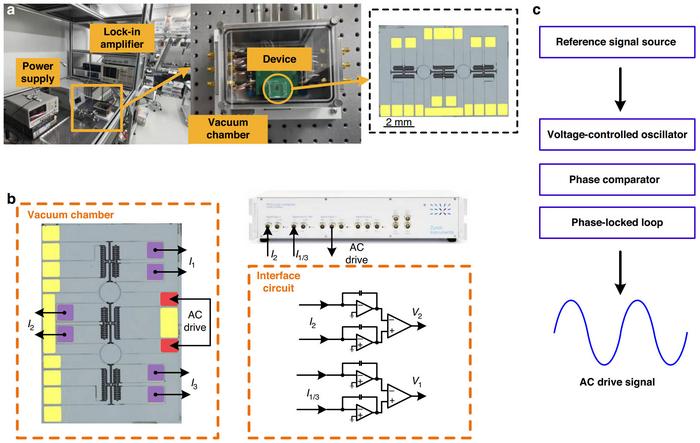
Simultaneous signal detection is a cornerstone of advanced sensor technology, particularly in the realm of microelectromechanical systems (MEMS). Over the years, the development of MEMS sensors has significantly shaped industries—from automotive to healthcare—by providing precise measurements through miniature devices. Nevertheless, a considerable challenge persists when attempting to detect multiple signals concurrently, owing to the inherent cross-sensitivity that leads to interference and degradation in performance. In a groundbreaking study, researchers from Northwestern Polytechnical University in Xi’an, China, have made significant strides toward surmounting this barrier. They introduce a novel constant-drive method featuring weakly coupled resonators, an innovation poised to redefine multi-signal detection.
The primary obstacle that researchers have grappled with lies in the need for MEMS sensors to maintain sensitivity while simultaneously managing cross-talk between signals. Traditional mode-localized sensors have illustrated notable sensitivity, yet they often fall short when tasked with discerning overlapping signals. Such interference muddles measurements and complicates signal interpretation, revealing a pressing demand for improved methodologies to facilitate high-fidelity, simultaneous signal detection.
Published on May 9, 2025, in the journal Microsystems & Nanoengineering, the researchers detailed their innovative constant-drive technique tailored for weakly coupled resonators. This development serves to synchronize the detection of dual signals with minimal interference, addressing an enduring limitation within MEMS sensing technology. Their approach stabilizes the driving frequency, effectively disentangling the interactions between multiple input signals, thereby preserving both accuracy and sensitivity.
.adsslot_9eJWPwHdjz{width:728px !important;height:90px !important;}
@media(max-width:1199px){ .adsslot_9eJWPwHdjz{width:468px !important;height:60px !important;}
}
@media(max-width:767px){ .adsslot_9eJWPwHdjz{width:320px !important;height:50px !important;}
}
ADVERTISEMENT
At the heart of the study lies a tri-resonator MEMS structure, composed of three weakly coupled mechanical elements engineered to detect input signals through variations in stiffness. Conventional mode-localized systems struggle under the burden of overlapping signals, as any change in input modifies the resonant frequency of the system, leading to confusion and erroneous measurements. The constant-drive technique reverses this predicament by maintaining a steady driving frequency, obstructing one signal from influencing another, and thereby halting the cycles of interference that plague existing systems.
The researchers undertook rigorous theoretical analyses under ideal, non-damped conditions, illustrating complete isolation between the signals detected. Following this, finite element modeling began to account for real-world damping effects, revealing astounding improvements—cross-sensitivity diminished to a mere 0.054%. Furthermore, empirical testing confirmed these findings; the cross-sensitivity plummeted from over 26% to just 1.1%. Remarkably, this enhancement in cross-sensitivity occurred without compromising signal sensitivity, marking a substantial leap in MEMS functionality.
Prof. Honglong Chang, the senior author of the study, emphasized the magnitude of this breakthrough by declaring it more than merely a refinement. “What we’ve demonstrated represents a fundamental shift in the operational paradigm of MEMS sensors and how they process multiple signals,” he remarked. The elimination of the need to respond to shifts in resonant frequency streamlines the system, allowing for reductions in both complexity and energy consumption. This methodology lays the groundwork for reliably capturing real-world phenomena, which frequently occur concurrently, such as vibrations and forces or electric and magnetic fields.
This revolutionary advancement opens a vast array of opportunities across diverse sectors such as aerospace, biomedical diagnostics, and industrial automation. Notably, the constant-drive technique’s applications do not end with accelerometers; its versatility extends to electric field sensors, force detectors, and other resonator-centered measurement systems. The simplified nature of this method could also serve to reduce technical barriers and energy costs typically associated with MEMS integration, particularly in mobile, wearable, or remote sensing applications. As the demands for sensor capabilities rapidly evolve within smart environments, this innovation provides a robust framework for the next generation of multi-functional, high-performance sensing platforms.
To validate their constant-drive approach, the researchers explored various applications, demonstrating that its utility transcends specific signal types. By leveraging the innate characteristics of weakly coupled resonators, this approach showcases potential adaptability for future MEMS devices, inspiring innovative configurations and unearthing new measurement possibilities.
Furthermore, the researchers noted that the implications of their work extend far beyond academia, encouraging the development of smarter devices capable of processing complex signals with unprecedented clarity and accuracy. This is significant as the landscape of technological requirements continues to shift toward greater integration, with simultaneous signal detection being a critical factor in the evolution of increasingly sophisticated systems.
The successful implementation of the constant-drive technique heralds a new era in MEMS research and applications. It exemplifies an intersection of creativity and scientific rigor, translating theoretical insights into practical solutions that stand to redefine sensor capabilities. As further advancements materialize, the implications for both industry and academia remain profound. Researchers and technologists alike will undoubtedly observe the evolution of MEMS sensors, reshaped by this novel methodology that prioritizes precision, efficiency, and practicality.
In conclusion, the research underscores the urgent need for advancements in sensor technology that can keep pace with complex environments. The constant-drive technique serves as a prime example of how engineering ingenuity can meet those demands. As industries continue to explore applications of refined sensing technology, there is a growing anticipation for the ensuing innovations that will arise from this breakthrough. With ongoing research and development, we can look forward to intelligent, multi-signal MEMS sensors that seamlessly integrate into our daily lives, enhancing everything from medical diagnostics to industrial processes and beyond.
Subject of Research: Constant-drive technique for weakly coupled resonators
Article Title: Synchronous detection of dual signals based on constant-drive technique of weakly coupled resonators
News Publication Date: May 9, 2025
Web References: Microsystems & Nanoengineering
References: DOI: 10.1038/s41378-025-00954-y
Image Credits: Microsystems & Nanoengineering
Keywords
Sensors, MEMS, dual signal detection, cross-sensitivity, constant-drive technique.
Tags: automotive applications of MEMS technologychallenges in multi-signal detectionconstant-drive method for signal detectioncross-sensitivity in MEMS sensorshealthcare applications of MEMS sensorshigh-fidelity measurements in MEMSinnovations in microelectromechanical systemsMEMS sensor technology advancementsMicrosystems & Nanoengineering research breakthroughsovercoming interference in signal detectionsimultaneous signal detection in sensorsweakly coupled resonators in sensors



